

Most of us recall this film playing only late at night
on TV. We never saw it at the theater; the reasons for that are
various, and we'll come to them soon enough. Suffice to say that
it was a sad fate for a thoughtful film.
Sir Hugo Cunningham (Robert Stephens) is one of those
Victorian gentleman scientists, a country squire with a taste for
the fledgling field of photography. We first meet him as he is bringing
home Anna (Fiona Walker), who will become his second wife, to introduce
to his now-adult children: Clive (Ralph Arliss), Christina (Jane
Lapotaire) and his adopted son Giles (Robert Powell). The children
are delighted that their father is going to marry again, and welcome
the woman with open arms.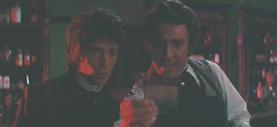
That evening, we also find that Sir Hugo is heavily
involved in Spiritualism, as he addresses a Society meeting while
displaying photographs taken at the moment of death by three different
photographers: each shows a smudge above the dying person, which
Hugo and Society head Sir Edward (Alex Scott) feel is the soul leaving
the body.
Things take a turn for the tragic as Sir Hugo is trying
out his new motion-picture camera, shooting his family as they punt
across the river which cuts through his estate. Attempting to extricate
his pole, stuck in the muddy bottom of the river, Clive does not
see a tree branch aimed squarely at his head; the blow knocks him
out of the boat and upsets it. Knowing that Clive's passenger, Anna,
cannot swim, Giles dives into the river over and over, but its murky
water foils his rescue attempts. Clive's body is found on the river
bank that night - Anna's is never recovered.
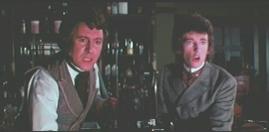 Two
weeks later, the grief-stricken Hugo develops his movie film and
is watching his last memento of his son and fiancee when he sees
the eerie smudge again, over Clive... but the smudge is not moving
away from the man, as the soul should at the moment of death,
but it is moving toward him as he strikes his head. Giles,
Hugo's partner in much of his experimentation, is equally mystified.
Two
weeks later, the grief-stricken Hugo develops his movie film and
is watching his last memento of his son and fiancee when he sees
the eerie smudge again, over Clive... but the smudge is not moving
away from the man, as the soul should at the moment of death,
but it is moving toward him as he strikes his head. Giles,
Hugo's partner in much of his experimentation, is equally mystified.
Hugo then receives a visit from Sir Edward, who brings
shocking news: there is to be a public execution by hanging. Apparently
Edward and Hugo are also part of a coalition to abolish capital
punishment, and Edward asks that Hugo record the execution with
his moving picture camera for use as propaganda. Hugo reluctantly
agrees. When Giles, who was to assist him, leaves the spectacle
in disgust, Hugo finds himself having to work two pieces of machinery
alone - when the sun goes behind a cloud, he fires up a spotlight
of his own design so that there may be enough light to photograph
the hanging.
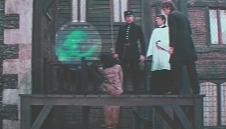 The
crowd gasps in fear as they see a ghastly figure revealed in the
unnatural light, as the condemned man drops through the trap door.
Hugo cranks away at his camera as the thing in the light seems to
strain at the edge of the light, apparently trapped... and the hanged
man, his neck broken, continues to convulse and struggle, until
Hugo turns off the light, the ghostly figure vanishes... and the
condemned man finally dies.
The
crowd gasps in fear as they see a ghastly figure revealed in the
unnatural light, as the condemned man drops through the trap door.
Hugo cranks away at his camera as the thing in the light seems to
strain at the edge of the light, apparently trapped... and the hanged
man, his neck broken, continues to convulse and struggle, until
Hugo turns off the light, the ghostly figure vanishes... and the
condemned man finally dies.
Hugo now theorizes that what he captured temporarily
is what he calls the Asphyx, after a creature in Greek mythology.
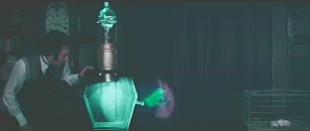 Literally,
a spirit of death that comes to each living thing in its moment
of expiration. The spotlight, which produces its light through a
reaction between water and "phosphate crystals", somehow
stops and imprisons the Asphyx. He and Giles test out this theory
by feeding a guinea pig poison and trapping its Asphyx in the beam
of light, then forcing it into a small coffin-like device which
has it's own chamber full of crystals and a bottle dripping water
on them, filling the coffin with the same imprisoning light. Its
Asphyx thus contained, Hugo feeds the twitching guinea pig an antidote.
As long as its Asphyx is contained, the guinea pig is immortal.
Literally,
a spirit of death that comes to each living thing in its moment
of expiration. The spotlight, which produces its light through a
reaction between water and "phosphate crystals", somehow
stops and imprisons the Asphyx. He and Giles test out this theory
by feeding a guinea pig poison and trapping its Asphyx in the beam
of light, then forcing it into a small coffin-like device which
has it's own chamber full of crystals and a bottle dripping water
on them, filling the coffin with the same imprisoning light. Its
Asphyx thus contained, Hugo feeds the twitching guinea pig an antidote.
As long as its Asphyx is contained, the guinea pig is immortal.
Moving things up to the next level, Hugo visits a
poorhouse which he finances and recruits a man who is dying of consumption
(Terry Scully). Hugo cares for and feeds the man, generally making
him comfortable until the consumption claims him, at which time
Hugo and Giles trap the man's Asphyx. They attempt to coax the Asphyx
into another chamber, but the man, in agony, makes Hugo release
the trigger of the spotlight by throwing acid in his face. The Asphyx
is released, and the man dies.
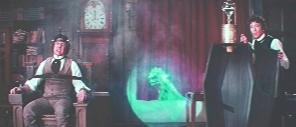 Though
his face has not healed, Hugo redoubles his efforts, constructing
an electric chair that he may have a tractable subject - himself
- for the experiments. Throwing the switch under his own right hand,
Hugo begins the process of dying, and Giles traps his Asphyx - only
to find that neither man thought the experiment through, and a second
set of hands is needed to adjust the prison chamber. Fortunately,
Christina was roused by the commotion, and though terrified, she
operates the spotlight while Giles imprisons the Asphyx.
Though
his face has not healed, Hugo redoubles his efforts, constructing
an electric chair that he may have a tractable subject - himself
- for the experiments. Throwing the switch under his own right hand,
Hugo begins the process of dying, and Giles traps his Asphyx - only
to find that neither man thought the experiment through, and a second
set of hands is needed to adjust the prison chamber. Fortunately,
Christina was roused by the commotion, and though terrified, she
operates the spotlight while Giles imprisons the Asphyx.
While Hugo recovers from his electrocution, Giles
sets up the prison chamber in the family crypt, attaching the crystal
container to a water pipe that the light will continue, unmanaged.
As Hugo has instructed, Giles then fits the single metal door to
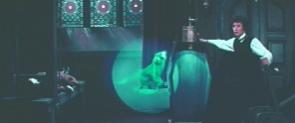 the
crypt with a combination lock, then hides the combination. Hugo
sets about planning to immortalize the rest of his family. Christina
takes a lot of convincing; eventually, Hugo simply bullies her into
it by threatening to disallow her marriage to Giles. For Christina's
immortalization, the men rig up a guillotine whose blade can be
stopped partway down its traverse, and Sir Hugo rigs a hose carrying
water to the prison chamber, to ensure a steady flow of water to
the crystals.
the
crypt with a combination lock, then hides the combination. Hugo
sets about planning to immortalize the rest of his family. Christina
takes a lot of convincing; eventually, Hugo simply bullies her into
it by threatening to disallow her marriage to Giles. For Christina's
immortalization, the men rig up a guillotine whose blade can be
stopped partway down its traverse, and Sir Hugo rigs a hose carrying
water to the prison chamber, to ensure a steady flow of water to
the crystals.
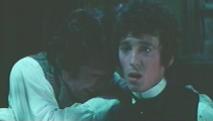 Alas,
Christina had earlier set the immortal guinea pig free, and the
treacherous beast chews a hole in the water hose, extinguishing
the light within the prison. As Hugo runs to the chamber to set
things aright, he jostles the levers controlling the guillotine,
and the blade slams down on Christina, decapitating her. Both men
stand shocked and horrified for a moment, then Hugo frees her Asphyx,
allowing his bisected daughter to die. The grief-stricken Giles
attempts to throttle him, but in the movie's single intentional
laugh, Hugo tiredly informs him, "You can't kill me, Giles.
Nobody can."
Alas,
Christina had earlier set the immortal guinea pig free, and the
treacherous beast chews a hole in the water hose, extinguishing
the light within the prison. As Hugo runs to the chamber to set
things aright, he jostles the levers controlling the guillotine,
and the blade slams down on Christina, decapitating her. Both men
stand shocked and horrified for a moment, then Hugo frees her Asphyx,
allowing his bisected daughter to die. The grief-stricken Giles
attempts to throttle him, but in the movie's single intentional
laugh, Hugo tiredly informs him, "You can't kill me, Giles.
Nobody can."
Later, Giles finds Hugo searching his desk, trying
to find the combination - it is his intention to release his Asphyx
and die. Giles promises Hugo that he will open the locked crypt,
but only if Hugo immortalizes him first, as promised - Giles says
he intends to use his immortality to make amends for Christina's
death. However, this is all a part of an elaborate revenge/suicide
plot on the part of the mourning Giles. The young man switches the
crystals in the spotlight (the new crystals are white, so we cannot
make the obligatory joke about Folger's Crystals), then burns the
sole copy of the combination, placing the ashes in an envelope,
which he hands to Hugo before he steps into the new Death Machine:
a makeshift gas chamber, employing the deadly gas from a wall light.
When the spotlight will not fire up, Hugo immediately
stops the flow of 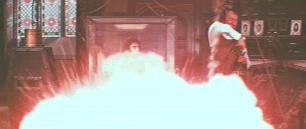 gas
to the cubicle, and bustles about to feeding oxygen to Giles. However,
Giles breathes, "Christina..." and strikes a match, blowing
himself to kingdom come. The distraught Hugo staggers to the crypt,
pulling out the envelope... then he stops short, remembering Giles
words about making amends. Then he burns the envelope himself, never
discovering his young assistant's duplicity. Hugo clutches the guinea
pig to him, "My only companion in immortality..."
gas
to the cubicle, and bustles about to feeding oxygen to Giles. However,
Giles breathes, "Christina..." and strikes a match, blowing
himself to kingdom come. The distraught Hugo staggers to the crypt,
pulling out the envelope... then he stops short, remembering Giles
words about making amends. Then he burns the envelope himself, never
discovering his young assistant's duplicity. Hugo clutches the guinea
pig to him, "My only companion in immortality..."
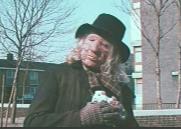 Move
forward about a hundred years... an old man walks slowly down the
street, dressed in tattered rags. He turns, revealing that he is
Hugo, wearing some of the worst old age make up ever put on screen.
He is also still holding the guinea pig... which has not aged
a day! Hugo steps into the street, directly between two cars
that crash together. Which is where the movie begins, with two policemen
dismayed that the man crushed between the two cars is still alive.
Hope you remembered back that far. The end.
Move
forward about a hundred years... an old man walks slowly down the
street, dressed in tattered rags. He turns, revealing that he is
Hugo, wearing some of the worst old age make up ever put on screen.
He is also still holding the guinea pig... which has not aged
a day! Hugo steps into the street, directly between two cars
that crash together. Which is where the movie begins, with two policemen
dismayed that the man crushed between the two cars is still alive.
Hope you remembered back that far. The end.
Glendale Entertainment, which made The Asphyx,
was one of the companies that attempted to fill the void as Hammer
began to stutter and stumble in the early 70's. There were two strikes
against this movie when it was first released in America: first,
they were distributed by a company that had before only distributed
softcore sex films; they had no idea how to sell such a cerebral
movie. The second, insurmountable obstacle was that it was 1973,
and a little movie called The Exorcist had opened. For better
or worse, The Exorcist skewed the movie-going public toward
much more visceral, splattery thrills, and The Asphyx could
not have competed with even the weakening Hammer films in that area.
Even when Christina is beheaded, we see no blood.
Asphyx's horrors are of a much more brainy sort, and most
of the horror comes from the deterioration of Sir Hugo's character.
At the beginning of the film, this man is arranging to have his
butler's ailing sister taken care of at his expense and informing
his son, with great sincerity and no condescension, "We Cunninghams
have our responsibilities." It is 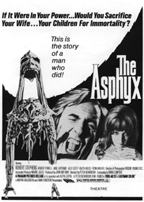 perhaps
a commentary on the ego of the British Upper Class that Hugo wants
to be immortal so that not only can he continue his philanthropy
for all time, but so he, and his family, may guide mankind through
its upcoming technological development. By the end of the movie,
this man - who is morally opposed to capital punishment - is building
execution devices in his own study. At the end, he sacrifices all
he holds dear - literally - to achieve his goal, his own Godhood.
perhaps
a commentary on the ego of the British Upper Class that Hugo wants
to be immortal so that not only can he continue his philanthropy
for all time, but so he, and his family, may guide mankind through
its upcoming technological development. By the end of the movie,
this man - who is morally opposed to capital punishment - is building
execution devices in his own study. At the end, he sacrifices all
he holds dear - literally - to achieve his goal, his own Godhood.
It's good, heady stuff, all played absolutely straight,
with nary a drop of irony, camp or melodrama, by a stunningly good
cast. Which only makes it hurt all the more when one must consider
the movie's shortcomings.
First come the scientific considerations. Even beyond
the idea that Hugo invented the motion picture camera decades before
Edison, there are those troublesome crystals that produce light
when water is splashed over them. Fair enough, but this means some
sort of interaction is taking place, which also means that something
is undergoing a chemical change to produce that light, and it's
probably not the water. Wouldn't they have to refresh the supply
of crystals in the chamber occasionally, rather than just hooking
them up to a water drip and assuming all will be well for eternity?
It's hard to swallow that a metal door fitted with
a combination lock would foil a truly determined man with a drill.
Or that the masonry surrounding that door is impervious to a sledgehammer.
Why does Sir Hugo build ever more complicated death machines when
he has a perfectly good electric chair, which he already knows is
practically foolproof? Why do the filmmakers seem to think that
a guinea pig is the same animal as a rat?
There is a form of script known as the idiot story,
in which the story can not move forward unless all the characters
act like idiots. The Asphyx is not an idiot story, it is
an entirely different breed: the accident story. All the
major plot points are accident-driven. Hugo discovers the existence
of the Asphyx by accident. Fair enough. Finding out he can trap
the beastie by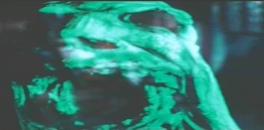 accident is stretching it. Losing Christina to a contrived accident
simply causes one to pause and think about the proceedings too much.
accident is stretching it. Losing Christina to a contrived accident
simply causes one to pause and think about the proceedings too much.
Most other movies would employ some sort of sleight
of hand to distract you from these things; some gore perhaps, or
a bit of skin. The Asphyx, though, is a class act, and eschews
these things - unfortunately, to its ultimate detriment.